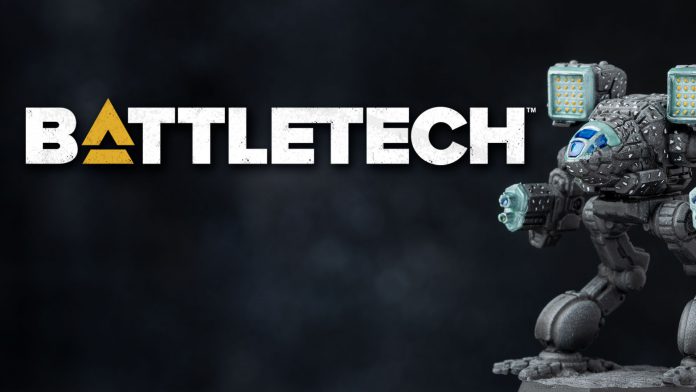Battletech is a very, very wide game with a lot of possibilities and a ludicrously fragmented meta. I covered the basics of building a good lance/formation a while ago, but one thing not mentioned in that article was what sorts of formations you would even want to be building. List Archetypes are a big thing in some other wargames, like Star Wars Armada or Warhammer 40k, and they do exist in Battletech, they just are not talked about or thought about very often. Generally the discussion in Battletech is about specific single mechs or variants and how strong they are on their own, not so much how they interact with the rest of your force. C3 is a notable exception, but that is a whole can of worms that made this article way too long, so it will be discussed at a later date.
I am going to talk about 4 archetypes in this article, which in my experience tend to be the most common ones to run into. There are many more, hence the part 1 in the title (The second part is probably mostly just going to be about C3 lists). The ones for this week are the Ravannion Special (light mech spam), Lyran/Inner Sphere Wall of Steel (cheap heavy mech spam), Elite/Clan (Few high tech/high skill units), and Take All Comers lists. There are more archetypes, but, again, these are in my experience the most common ones. Each wants a different sort of mech, and a different mentality towards the game, and all of them have more or less equal merit due to BV being a reasonable balancing system. This article will generally be assuming you are running 10000 ish BV with a cap on the amount of units you are allowed to take, and you are playing a pick up or competitive game, rather than a narrative one. One thing to bear in mind as we go through is that these are by no means the only types of list, and you can and should mix together these styles to create more flexible, rugged lists that are harder to counter.
Ravannion Special
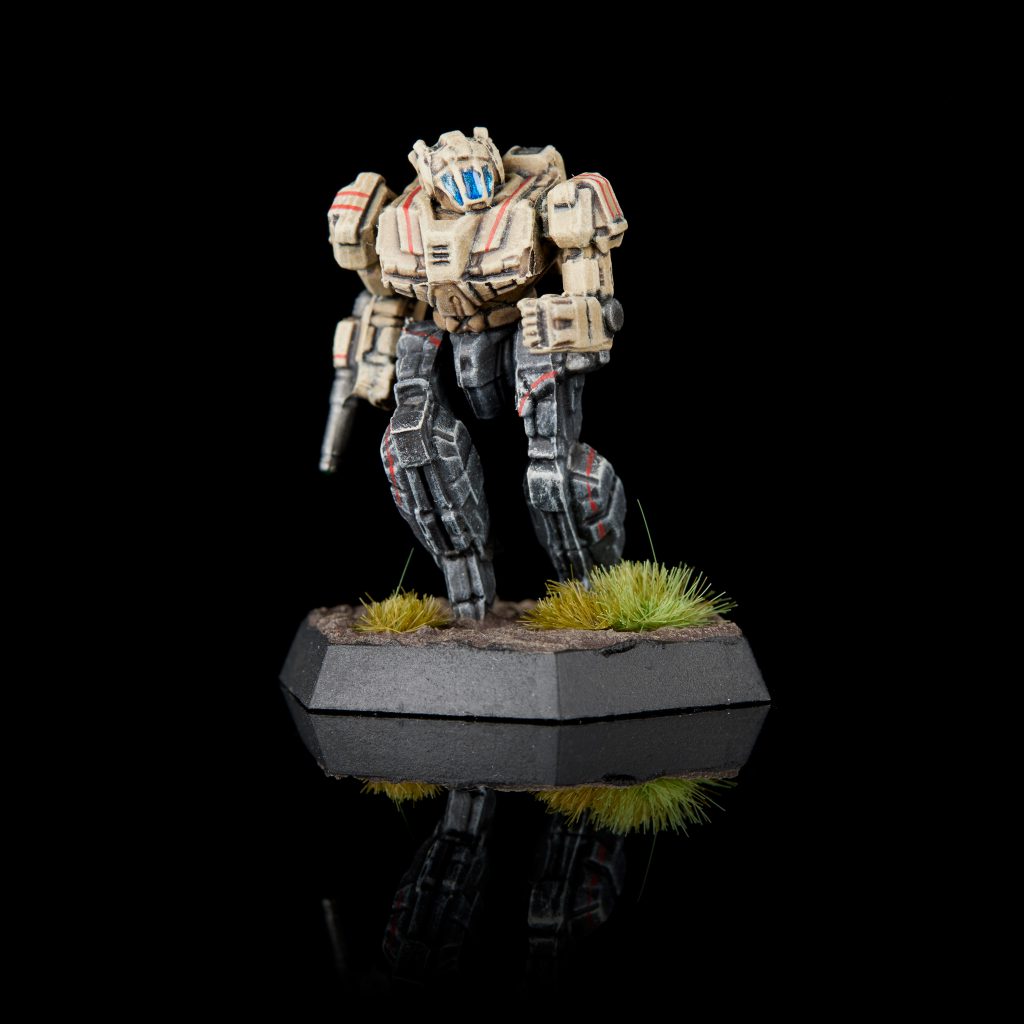
Named after Mercer Ravannion, a character from one of the very earliest Battletech lore books, the Ravannion special relies on overwhelming numbers of cheap, fast, slippery light mechs. The advantages of this sort of list is that you will generally get to pick all of your engagements, as well as providing so many targets that it can be difficult for your opponent to find the easiest shot out of all of them, and a swarm like this can often hit and fade, with damaged units rotating to the back as fresh ones come forwards. You can also frequently maneuver into rear arcs, where your limited weaponry matters a lot less into the thin rear armor most mechs have. This style of force also completely rocks at any scenario that involves objectives, because you will frequently have better mobility than your enemy. The main disadvantage is that any serious hit to any part of most of your mechs will nearly instantly kill or cripple them. These sorts of mechs tend to be very short ranged as well, and your entire list will have a crippling allergy to pulse lasers and precision ammo. Another issue is that you will struggle on flatter maps with less terrain, because it will be much harder to pull damaged units out of a fight.
The sorts of mechs and variants that this list wants is very simple. Anything less than 1000 BV, with a movement of at least 6/9. If you are playing without a maximum unit count, I would recommend going mostly for Wasps, Spiders, and Stingers, with a couple of slightly heavier light mechs, like Jenners, Piranhas, and Mist Lynx. Ideal play is using the ultra cheap 500 BV losers to soak shots and fish for rear arc shots, ganging up on enemies and making sure that each of your opponent’s mechs is fighting two or more friendly ones, and the more expensive 900-1000 BV losers to finish things off and apply pressure to the enemy. If you have a maximum unit limit, shift heavier, with the bulk of your force being Jenners and other fast 30-35 tonners, with a few fast mediums like the Wraith or Griffin 4R. The playstyle is still mostly the same, with less of a focus on the swarming and ganging up on things and more focus on getting behind things and backstabbing them to death.
All in all this is a high risk, high reward way to play. You are very brittle in a stand up fight, but with good movement and maneuvering you can kill much larger mechs with a death of a thousand cuts from the annoying little bee stings from your crappy light mechs, and you are surprisingly difficult to stop due to high TMMs and heavy unit redundancy. In terms of the Map Sheets that your list would like best, anything with short sightlines and lots of level 3 and level 4 terrain to jump over to disengage will be very strong for you. The craggier and rougher the terrain, the better.
Here is a couple of sample 10000 BV lists for the Ravannion Special, one with no limit and one with a 8 mech limit.

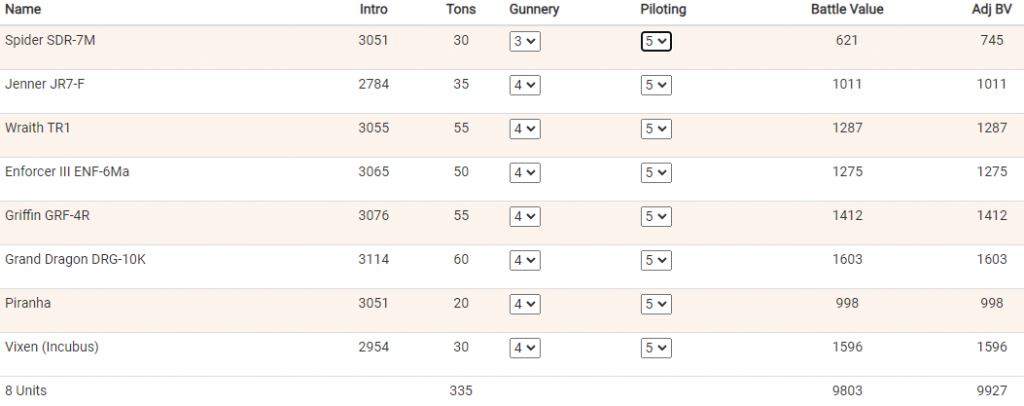
Lyran Wall of Steel
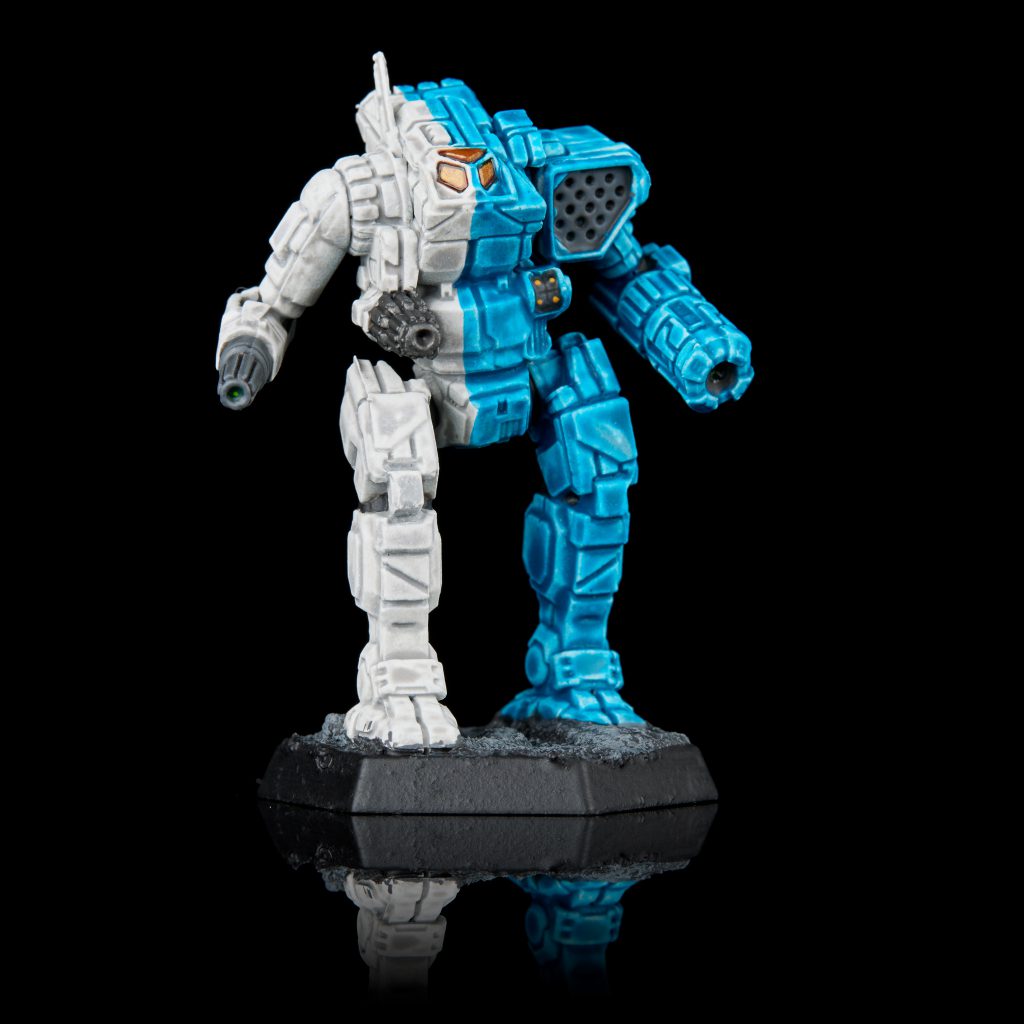
The estranged older brother of the last archetype and my personal favorite, the Lyran Wall of Steel, also called the Steiner Scout Lance or Intro-tech Special, is a force that focuses on heavy, slow, cost effective mechs. The name comes from the in universe joke about the Lyran Commonwealth/House Steiner being so rich that they use assault mechs for everything, even scouting. This is distinct from an Elite list because the mechs tend to be pretty low tech and slow, which makes them cheap and numerous. Thunderbolts, Orions, Banshees, Atlas’, Awesomes, Hunchbacks, and Thugs are all at home in a Wall of Steel, all being 4/6 or 3/5 plodding monsters covered in thick armor. The sorts of mech this force wants are generally anything below 1600-ish BV that has heavy armor, preferably at least 25 in the center torso, ideally more, with a secondary concern being a good combination of long range and short range damage.
The strengths of this force is that, BV for BV, slow, heavily armored mechs are insanely efficient. They can carry a decent amount of gun and take a lot of punishment. A 1000 BV Jenner JR7-F has 15 center torso armor, but a 1000 BV Hunchback 4H has 26. They are slower and tend to get hit more often, but they are much less susceptible to a single hit from a large weapon landing and completely destroying them. In addition, the Hunchback 4H has a 30 point alpha strike at close range, with 10 points at mid/long range, while the Jenner only has 20 at short and none at mid or long. Now, the Jenner will have an easier time getting into range, but once it is there it does a lot less damage.
Wall of Steel type forces need some getting used to, they have a fair number of serious weaknesses and advantages. The main advantages are that your mechs are stupidly tough, and you will basically always have more Tonnage on the field, which can translate to more big guns and more chances to get lucky and blow a component off with a single lucky shot. Disadvantages are that this archetype is slow. Really slow. Next level slow. You will generally not be able to pick your fights, and you need to position carefully to punish your opponent for trying to get behind your mechs. In addition, there is a serious risk of being out-ranged, so it is important that you have some PPCs or LRMs on most if not all of your mechs, just to make sure that you have a chance to shoot back at anything trying to kite you.
The Wall of Steel excels on any defense mission, or any mission that involves taking and holding an objective for an extended amount of time. Most forces are unhappy to stand still on a point, but the Wall of Steel tends to be so slow that it really doesn’t make much of a difference. Attacks can be alright if the enemy can’t just run away from you the whole game. Anything that relies on or benefits good mobility is a little rough for the Wall of Steel though. In terms of map sheets, the Wall of Steel really likes cities and any other maps where there are a lot of choke points and you can force the opponent to fight you in just a few areas.
Here is a good, proper, house Steiner approved Wall of Steel list

Elites/Clan

Elites is an archetype defined by a small number of very high tech units, sometimes but not always with higher skill than normal. Generally any Clan force will fall into this, as will ComStar and Word of Blake. Any mech is fair game in an Elite force, but generally mechs costing between 2000 and 3000 are most common. Thors, Mad Cats, Black Hawks, Ryokens, and other Clan Mechs are the platonic ideal of an ideal Elite mech, being fast for their weight and very heavily armed with incredibly good weapons. These sorts of forces can load up with slow assault mechs and try to win just on firepower alone, but generally they are much stronger if every mech is in the 5/8 or 6/9 movement bracket, as this gives them great mobility, and their high tech lets them move that fast and still carry a ton of gun.
The main advantage of a heavily elite force is that you concentrate more power into a smaller space than your opponent does. This is also it’s primary weakness. The concentration of power means that you will nearly always win a 1 on 1 fight, and elite assault mechs in particular can point at any given light or medium and decide that it no longer gets to live on the same planet. Dire Wolves and Turkinas are particularly good at unmaking any small mech that dares to stand vaguely near them. The main issue with this concentration of force is that you become very vulnerable to headshots and falling over. If you have 4 mechs and your opponent has 8, then each one shot headshot that happens to you is twice as bad as if it happened to your opponent. This also applies to unlucky crits and unconsciousness rolls. However, if you can isolate an enemy mech and rip into it with one or two of your mechs, probably using your superior movement, very few things in this game can actually survive being beaten on by a couple of high tech mechs unsupported for more than a single turn.
I generally am not a huge fan of high tech forces in Battletech, because having a smaller number of units makes me nervous, and headshots happen exactly often enough for me to want to reduce my chances of having one take a quarter of my list away. However, about half of my local play group, and several other contributors to Goonhammer.com, hit tabletop gaming website, really enjoy this playstyle. It is very flashy, and your games tend to be over pretty damn fast one way or another, which can be a huge bonus if you have less playtime, because the higher movement speed and greater weapons load makes for some blindingly fast and incredibly violent games.
Here is a sample list for a dirty clan force that should do a pretty good job of murderizing anything you point it at.

Take All Comers

Take All Comers lists, or TAC lists, are sort of the ideal combination of the above. Rather than taking any one aspect of the game and pushing it to an extreme, like the previous, these lists attempt to have a tool for every situation. Generally these forces will be mostly mediums and heavies. A good TAC list will generally be fairly mobile, though not screamingly fast, with a few well armored line holders, and a couple of high tech/high quality damage dealers to finish things off. Mechs like the Griffin, Wolverine, Trebuchet, Enforcer, Grasshopper, Dragon, and Thunderbolt tend to show up in these lists, solid mechs that are good in more than one situation, happy to be either at long range or close range. Ideally you don’t have any super specialized mechs, and stick pretty close to either a 5/8 or 4/6/4 movement profile for mobility.
TAC lists are generally pretty strong, because no matter what terrain or situation you run into, you hopefully have a tool. Most of the mechs I recommended mount some mixture of weapons, rather than relying on a single type, so you don’t get punished too hard by running into the armor type that counters your damage. You also will rarely be completely outmaneuvered, out tonned, or outgunned. You also frequently have something the enemy doesn’t. You can out ton and bully light mech swarms, outmaneuver and outplay the Wall of Steel, and outnumber and out ton elites. The issue is that if any of the other major archetypes can get you in their ideal situation, you are probably going to lose, so a huge part of the skill of taking a TAC list is figuring out how to keep your opponent from pulling off her game plan.
I like these lists quite a bit, even if I personally prefer to run the Wall of Steel. TAC lists are great to learn with, and I generally recommend them to new players, because you will learn which type of mech you like, and what you enjoy doing with your force by taking a bit of everything.
Here is a good sample list for a TAC type list. Nice mid-speed, reasonable damage jerks, with a bit of everything.
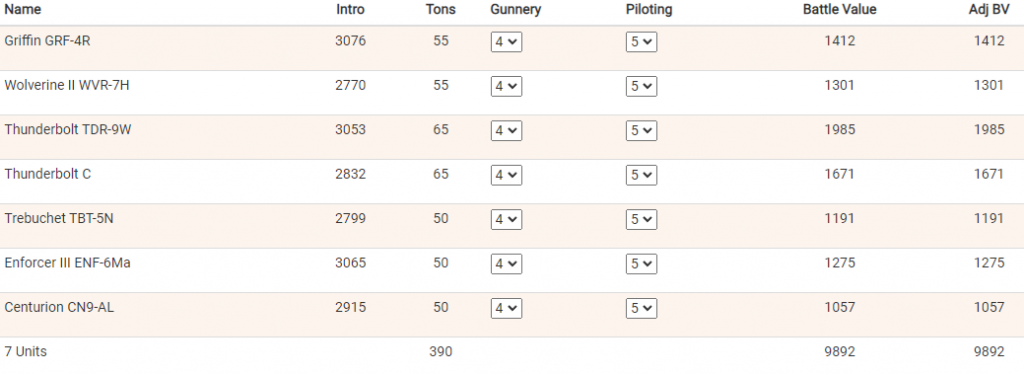
Conclusion
Battletech is a great game, and I really hope that this helped give a bit of an idea what sort of thing your list should even be doing. One of the biggest things that I would take away is that it is very important to make sure that your list stays focused. It can be very easy to end up with a mostly unfocused mess of mechs, and the player with a game plan will nearly always win against the player without one. That applies to all wargames, but Battletech is a game with such a huge amount of units that it goes double here, because there are so many options and so many gameplans you can create. Also, take more Banshee’s, Enforcer IIIs, Griffins, and Thunderbolts. Those are just kinda generically good.
